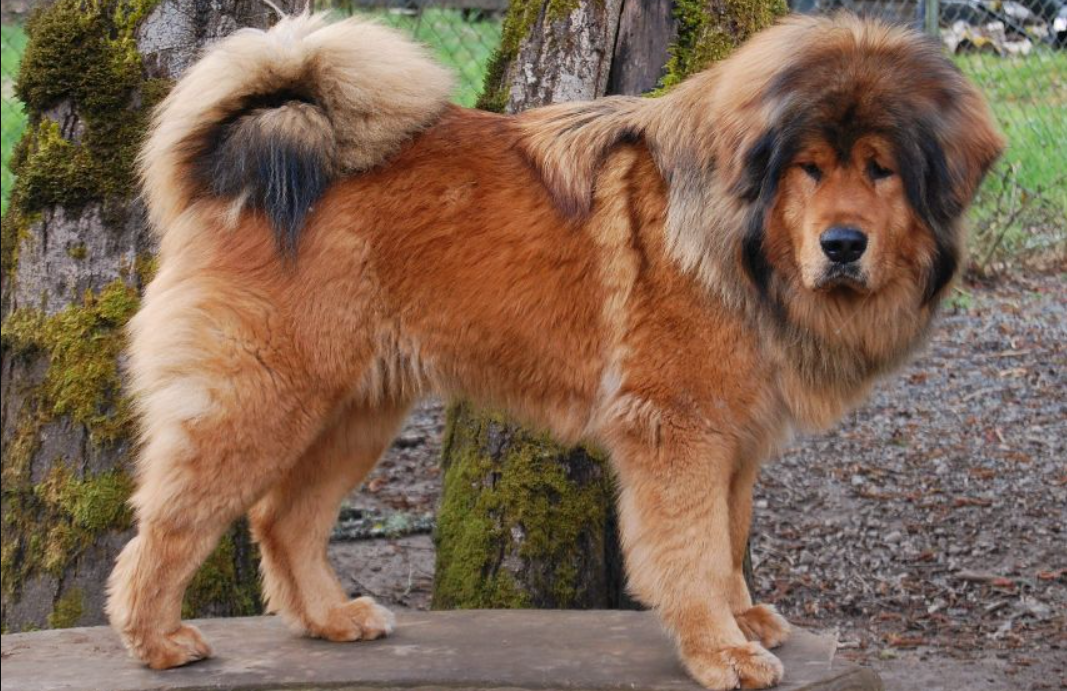Tibetan Mastiff Dog, Puppy Price, Weight & Breed Special Information
The Tibetan Mastiff is a large Tibetan dog breed. Its double coat is medium to long, subject to climate, and comes in a variety of colors, including solid black, black and tan, various shades of red (from light gold to dark red) and blue-grey (thin black), and sometimes With white markings around the neck, chest, and legs.
Tibetan Mastiff Dog Breed Size Chart & Overview:
| GROUP: Working HEIGHT: 24 to 26 inches tall at the shoulder WEIGHT: 70 to 150 pounds COAT: Double outer coat is fine but hard, straight, and stand-off; the undercoat is heavy, soft, and woolly COAT COLOR: Black, brown, blue/grey, or gold LIFE SPAN: 10 to 12 years TEMPERAMENT: Intelligent, protective, strong-willed, tenacious, aloof HYPOALLERGENIC: No ORIGIN: China (Tibet) |
Origin Of Tibetan Mastiff Gog Breed:
The ancestors of the Tibetan Mastiff are known to have existed in Tibet for several centuries. The history of what these dogs were crossed with to produce the Tibetan Mastiff is unfortunately lost. They began to appear in other countries when Alexander the Great took them with him on his travels around the world.
The Tibetan Mastiff as we know it today has existed outside of Tibet for over a century. The Prince of Wales owned at least one of these dogs in the 1880s and the breed standard was made in the 1930s.
History About Tibetan Mastiff:
The Tibetan Mastiff is one of the oldest breeds, considered the ancestor of all other mastiff breeds in the world. They are a guardian caste of Tibet who either travels with nomadic herdsmen, watch over their herds or serve as guardians of villages and monasteries.
Travelers often wrote about the ferocity of the dogs, which was encouraged by the residents. Chinese documents from 1121 BCE record Tibetan guard dogs that may be the ancestors of today’s TM. The dogs were called do-khi, meaning “tied dog”, because they were restrained during the day but allowed to roam at night.
Tibetan Mastiffs were first brought to the United States in the 1970s. The American Kennel Club recognized the breed in 2006. He is ranked 124th among dogs registered by the AKC.
Breed Characteristics of This Breed:
| Adaptability: 3 Points | Dog Friendly: 2 Points | Energy Level: 3 Points |
| Trainability: 3 Points | Exercise Needs: 3 Points | Affectionate: 3 Points |
| Grooming: 4 Points | Territorial: 5 Points | Watchdog Instincts: 5 Points |
| Apartment Friendly: 1 Point | Barking Tendencies: 5 Points | Cat Friendly: 3 Points |
| Child Friendly: 3 Points | Health Issues: 2 Points | Intelligence: 3 Points |
| Shedding Level: 4 Points | Social Needs: 3 Points | Stranger Friendly: 1 Point |
Appearance of Tibetan Mastiff:
The defining characteristics of the Tibetan Mastiff are its captain- suchlike mane and massive size. A full-overgrown lady can be 24 elevations or further at the shoulder, and a manly Tibetan Mastiff can be 26 elevations at the shoulder. Ladies weigh 70- 120 pounds and males 90- 150 pounds.
The thick double coat of the breed can be black, brown, blue-grey, red, or gold. Sometimes they have markings around the eyes, muzzle, throat, legs, and tail that vary from silver to mahogany. The outer texture of the coat is thick and coarse, while the inner texture is soft and woolly.
The Tibetan Mastiff requires little grooming, except during the annual spring-to-summer shedding, or coat shedding season when hair will be everywhere.
The tail is feathered, similar to the mane, and arches over the dog’s back. Always alert, serious, deep-set eyes can be any shade of brown.
Temperament / Temperamentally of This Dog Breed:
As a flock guardian dog in Tibet and exploration, he uses all the usual herding tactics to remove givers and resolve border confrontations. The Tibetan Mastiff can run up to 20 mph (32 km/h) over long distances.
As a social, more domesticated dog, he can thrive in a large, fenced yard with a canine companion, but he is not the right dog for apartment living. Western dogs are generally more docile, though still somewhat aloof from strangers. Through hundreds of years of selective breeding for protective herds and family guardians, the breed has been prized as a nocturnal sentinel, keeping predators and intruders at bay and barking at unfamiliar sounds throughout the night.
It is not recommended to leave the Tibetan Mastiff out with the neighbors all night. They often sleep during the day, which makes them more active, alert, and awake at night.
Like all flock guard breeds, they are intelligent and stubborn to a fault, so obedience training is recommended as this is a strong-willed, powerful-bodied breed. Unless they are to be used solely as livestock guardians, socialization training is also important with this breed, as they have a reserved nature with strangers and guardian instincts.
They can be excellent family dogs depending on the family; Owners must understand canine psychology and be able and willing to spend a lot of time and dedication training their dogs. A lack of consistency can result in the formation of unpredictable dogs. Protecting Tibetan Mastiffs requires vigilance and planning by the owner, to avoid accidents when the dog is only reacting as a guardian. The breed is not recommended for novice dog owners.
Personality / Personality Traits Of Tibetan Mastiff Gog Breed:
The term “insolent” is often used for this independent, stubborn breed. He is intelligent and has a strong sense of self, expecting to be treated as an equal rather than a pet.
He wants to please his people, but he also has his own agenda and must be reminded often of what he is called to do. The Tibetan Mastiff is a loyal family guardian who takes his job seriously and is aloof or reserved towards strangers.
Early socialization that continues throughout his life will help him become territorially aggressive. Enrolling him in puppy dog kindergarten classes is a great start.
Regularly inviting visitors, and taking him on leisurely walks to busy parks, and stores that allow dogs, and to meet neighbors will also help him polish his social skills.

Health About This Dog Breed:
Many breeders claim a lifespan of 10-16 years, but these claims are unproven. Some lines produce long-lived dogs. Other, more closely bred lines, produce short-lived, unhealthy dogs.
The breed has fewer genetic health problems than many breeds, but cases of hypothyroidism, entropion, ectropion, distichiasis, skin problems including allergies, autoimmune problems including Demodex, Addison’s disease, Cushing’s disease, missing teeth, malocclusion are seen. dry mouth), cardiac problems, seizures, epilepsy, progressive retinal atrophy (PRA), cataracts, and small ear canals that are prone to infection. As with most large breeds, some will suffer from elbow or hip dysplasia.
In the early 1980s canine hereditary demyelinating neuropathy (CIDN), a hereditary condition appeared in one of the leading lines of Tibetan Mastiffs. Unfortunately, known carriers were widely bred and are still active behind many lines.
Breeding Because the mode of inheritance appears to be simply recessive, continued breeding may still produce affected puppies.
Hypothyroidism is quite common in Tibetan Mastiffs, as it is in many large “northern” breeds. They should be tested periodically throughout their lives using a complete thyroid “panel.” However, because standard thyroid levels were established using domestic dog breeds, test results must be considered in terms of what is “normal” for the breed, not what is common across all breeds.
Many dogs of this breed will have “low” thyroid values, but no clinical symptoms. Veterinarians and owners differ on the relative merits of medicated dogs that test “low”, but are completely asymptomatic.
How to Care for Your Tibetian Mastiff?
Moderate exercise in the form of regular walks is essential for the physical and mental health of Tibetan Mastiffs—they have a tendency to become obese. Because these dogs can be willful, their walk should always be leashed.
When training a Tibetan Mastiff, it is important to be positive and never punitive. “Training a Tibetan Mastiff should only be done with positive reinforcement,” says Chambliss. She says that this clever breed learns directly by seeing and experiencing life, so being positive and patient will teach them to be kind.
Brush your Tibetan Mastiff once a week and his grooming needs will be minimal for the rest of the year. That is, until the spring or summer shedding season hits. Then, a hurricane of hair will cover the house for weeks. A comb or de-shading tool can help.
How to Training Exercise of Tibetian Mastiff Dog?
As with all large and bulky breeds, exercise should be done with caution for puppies and young adults. Due to the Tibetan Mastiff’s large frame and heavyweight and hereditary joint conditions such as hip dysplasia, repetitive exercises such as jogging or jumping should be limited and/or completely avoided until the dog is at least two years old and fully mature. Even a fully mature Tibetan Mastiff will not make a jogging partner or agility champion, although most enjoy a leisurely walk between 30 and 60 minutes a day.
Adopt OR Buy From Rescue Group / Center:
Grooming of This Breed:
The Tibetan Mastiff is surprisingly easy to groom. A profuse coat sheds very little outside of a seasonal shed where the “coat blow,” losing almost all of their undercoat in just a few weeks. During this heavy shed, frequent brushing and a bath or two can help but expect hair everywhere. The rest of the year, the coat sheds very little and only requires weekly brushing and bathing when the dog gets dirty.
In addition to coat care and bathing, your dog needs regular teeth brushing and nail trimming.
How to Train Tibetan Mastiff?
Although the Tibetan Mastiff is highly intelligent and able to learn basic obedience skills quickly, they can also be stubborn and not always particularly inclined to do what you ask. Training should begin at an early age and the rules should be consistently enforced throughout the dog’s life.
Because the Tibetan Mastiff is physically large and naturally suspicious of strangers, it is important that any Tibetan Mastiff owner be able to physically control their dog when necessary, whether in public or at home.
Even with intensive socialization (which is essential for this breed), Tibetan Mastiffs can be difficult to train. Large and powerful, the breed’s protective instincts are so high that some Tibetan Mastiffs don’t always listen when their owners tell them that visitors are allowed and that intruders are not allowed to be beaten.
More Dog Breeds And Further Research:
Top 10 Facts About Tibetan Mastiffs:
FAQs About Tibetan Mastiff Dogs:
Is Tibetan Mastiff really big?
A male Tibetan Mastiff stands at least 26 inches tall at the shoulder and weighs around 100 to 160 or more pounds; Females are at least 24 inches tall at the shoulder and weigh 75 to 125 or more pounds.
How much does a Tibetan Mastiff cost?
Tibetan Mastiff puppies are extremely rare and hard to find in the United States, but if you do find one, you can expect to pay anywhere from $1,500 to $5,000. Due to their rarity, they are very expensive. To put it in more perspective, they are considered to be the most expensive dog breed in the world.
How big do Chinese Tibetan Mastiffs get?
A full-overgrown lady can be 24 elevations or further at the shoulder, and a manly Tibetan Mastiff can be 26 elevations at the shoulder. Ladies weigh 70- 120 pounds and males 90- 150 pounds. With their large size and furry mane, the Tibetan Mastiff is nearly captained- suchlike.
Do Tibetan mastiffs really have lion’s blood?
“They have lion blood and are top-range mastiff studs,” dog breeder Zhang Gengyun told the paper.

